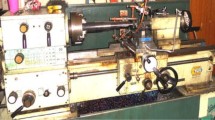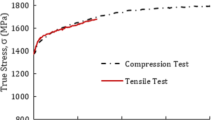Abstract
This paper presents a finite element method for the modeling of the hard turning of (AISI) 4340 steel. Abaqus/Explicit software was used for the numerical simulation. The aim of this study is to investigate the effect of cutting speed on the chip morphology. Associated with serrated chip formation, variation of cutting forces were observed. The parametric analysis of the coefficient of thermal conductivity during cutting process is also discussed. Moreover, the thermal field of the work piece, chip, and tool were investigated. The numerical results were validated with previous experimental data and were so similar.


Similar content being viewed by others
REFERENCES
Deshayes, L., Ivester, R., Mabrouki, T., et al., Serrated chip morphology and comparison with finite element simulations, ASME Int. Mechanical Engineering Congr. and Exposition, 2004.
Basavarajappa, S., Suresh, R., Gaitonde, V.N., et al., Analysis of cutting forces and surface roughness in hard turning of AISI 4340 using multilayer coated carbide tool, Mach. Machinabil. Mater., 2014, vol. 16, no. 2, pp. 169–185.
Das, S.R., Panda, A., and Dhupal, D., Hard turning of AISI 4340 steel using coated carbide insert: Surface roughness, tool wear, chip morphology and cost estimation, Mater. Today: Proc., 2018, vol. 5, pp. 6560–6569. https://doi.org/10.1016/j.matpr.2017.11.311
Khalifa, M. and Duyun, T.A., Finite element modeling of the cutting process during machining of structural steel using ANSYS Workbench, Vestn. Belgorod. Gos. Tekhnol. Univ. im. V.G. Shukhova, 2019, vol. 4, no. 11, pp. 121–127. https://doi.org/10.34031/2071-7318-2019-4-11-121-127
Khalifa, M. and Duyun, T.A., Classification and zoning of riverine territories of small towns on the example of the Belgorod region, Vestn. Belgorod. Gos. Tekhnol. Univ. im. V.G. Shukhova, 2020, vol. 5, no. 8, pp. 101–109. https://doi.org/10.34031/2071-7318-2020-5-8-101-109
Mabrouki, T. and Rigal, J., A contribution to a qualitative understanding of thermo-mechanical effects during chip formation in hard turning, J. Mater. Process. Technol., 2006, vol. 176, nos. 1–3, pp. 214–221. https://doi.org/10.1016/j.jmatprotec.2006.03.159
Priyadarshini, A., Pal, S.K., and Samantaray, A.K., A finite element study of chip formation process in orthogonal machining, Int. J. Manuf., Mater., Mech. Eng., 2011, vol. 1, no. 4, pp. 19–45. https://doi.org/10.4018/ijmmme.2011100102
Belhadi, S.‚ Mabrouki, T., Rigal, J., Boulanouar, L., and Belhfdi, S., Experimental and numerical study of chip formation during straight turning of hardened AISI 4340 steel, Proc. Inst. Mech. Eng., Part B, 2005, vol. 219, pp. 515–524.
Subbiah, S. and Melkote, S.N., Effect of finite edge radius on ductile fracture ahead of the cutting tool edge in micro-cutting of Al2024-T3, Mater. Sci. Eng., A, 2008, vol. 474, nos. 1–2, pp. 283–300. https://doi.org/10.1016/j.msea.2007.04.116
Mabrouki, T., Girardin, F., Asad, M., et al., Numerical and experimental study of dry cutting for an aeronautic aluminium alloy (A2024-T351), Int. J. Mach. Tools Manuf., 2008, vol. 48, no. 11, pp. 1187–1197.
Courbon, C., Mabrouki, T., Rech, J., et al., On the existence of a thermal contact resistance at the tool-chip interface in dry cutting of AISI 1045: Formation mechanisms and influence on the cutting process, Appl. Therm. Eng., 2013, vol. 50, no. 1, 1311–1325.
Johnson, G.R. and Cook, W.H., A constitutive model and data for metals subjected to large strains, high strain rates and high temperatures, Proc. 7th Int. Symp. on Ballistics, 1983, vol. 21, pp. 541–547.
Johnson, G.R. and Cook, W.H., Fracture characteristics of three metals subjected to various strains, strain rates, temperatures and pressures, Eng. Fract. Mech., 1985, vol. 21, no. 1, pp. 31–48.
Hillerborg, A., Modeer, M., and Petersson, P.E., Analysis of crack formation and crack growth in concrete by means of fracture mechanics and finite elements, Cem. Concr. Res., 1976, vol. 6, no. 6, pp. 773–782.
Funding
This work was supported by the Priority 2030 program at Shukhov Belgorod State Technological University, using equipment at the University’s high-technology center.
Author information
Authors and Affiliations
Corresponding authors
Ethics declarations
The authors declare that they have no conflicts of interest.
Additional information
Translated by B. Gilbert
About this article
Cite this article
Khalifa, M., Duyun, T.A. Simulation of the Turning of AISI 4340 Structural Steel. Russ. Engin. Res. 42, 502–505 (2022). https://doi.org/10.3103/S1068798X22050173
Received:
Revised:
Accepted:
Published:
Issue Date:
DOI: https://doi.org/10.3103/S1068798X22050173




